
This page last modified: 30 December 2015 (references rearranged)

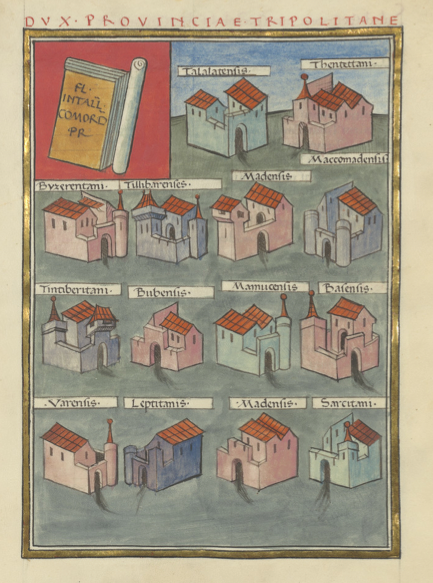 Above: Frontpiece from the Parisian manuscript (P). The station labels read: Talalatensis, Thentettani, Byzerentani, Tillibarensis, Madensis, Maccomadensis, Tintiberitani, Bubensis, Mamucensis, Basensis, Varensis, Leptitanis, Madensis, Sarcitani. |
The following commanders and their stations are listed as being under the command of the Dux provinciae Tripolitanae (i.e. the Duke of the Province of Tripolitania; the numbers in front of the names refer to Ingo Maier's numbering scheme):
139.2 Praepositus limitis TalalatensisExcept for the two units of milites ("milites" simply means "soldiers"), no names are given to these detachments, only their locations. Being limitanei units, no shield patterns are given either. |
The Milites Fortenses (139.13) would appear to be a detachment of the Fortenses listed (98/9.129) as the last of the legiones comitatenses in the Magister Peditum's infantry roster and assigned to the command of the Comes Africae. Munifices simply means "privates" - soldiers that were not specifically exempted from ordinary fatigues, and the Milites Munifices (139.14) probably represent another detachment of the same legion (it is possible that since no commanders are given for these detachments, they might have been under the command of the officer list immediately above them, the Praepositus limitis Varensis; it is also possible their commanders have simply been omitted). Note that praepositus was a position in the Roman army - a commander of a (detachment of a) unit, and not a substantive rank like praefectus or tribunus", in much the same way any commander of a modern naval ship may be called "captain", while very few such captains hold the rank of "captain". The men under the Praepositus limitis Fortensis (137.5) under the Dux et praeses provinciae Mauritaniae et Caesariensis might be another detachment of the same legion. The shield pattern of the Fortenses under the Comes Africae as shown in various manuscripts is as below:

Whether this pattern was borne by any limitanei detachments listed in the African provinces might depend on whether the detachments were detached from the unit in the field army, or the field army unit joined the field army from a garrison position: there is plenty of evidence in the Notitia to suggest that units were given new shield patterns when they joined a field army.
Note that in addition to the above mentioned units, various other units named Fortenses appear in the Notitia:
9.20 Fortenses, a legio palatina under the first Magister Militum Praesentalis,In addition, there is the Fortensia (143.27), a unit of auxilia under the Dux provinciae Valeriae ripensis. It is the relative positioning of the two legiones comitatenses called Fortenses units within their provincial lists that indicates which one is which: the Spanish unit is the first of the legions listed in the Spanish list, and thus should correspond to the more highly-positioned unit in the Magister Peditum's infantry roster; while the African unit is the last in the African list, and thus should correspond to the more lowly-positioned unit in the Magister Peditum's infantry roster.
15.28 Fortenses auxiliarii, a pseudocomitatenses unit under the Magister Militum per Orientem,
80.2 Dalmatae Fortenses, a cuneus of equites Dalmatae under the Dux Daciae ripensis,
98/9.99 Fortenses, a legion comitatenses unit under the "Comes" Hispenias,
132.2 Fortenses, a numerus under the Comes litoris Saxonici per Britanniam, and
143.6 Fortenses, a cuneus of equites under the Dux provinciae Valeriae ripensis.

Below are the frontpieces from the second half of the Munich manuscript (W) and the Froben edition (B).
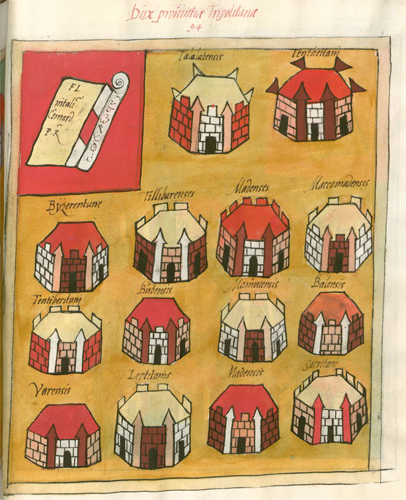
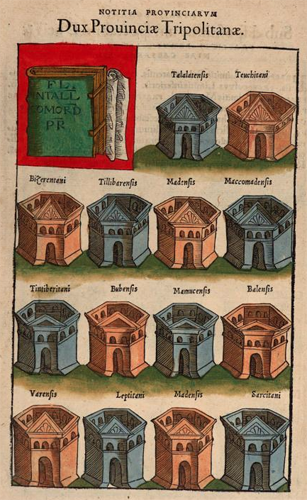
Both of these sets of pictures show the hexagonal style of fort illustrations that is believed to have been present in the lost Codex Spirensis from which all the extent manuscript copies are ultimately derived. Those of B show clear 16th-century renaissance embellishments to the styling, while those of W are clear of such anachronisms. Below are the corresponding frontpieces from the first half of the Munich manuscript (M) and the Bodleian manuscript (O).
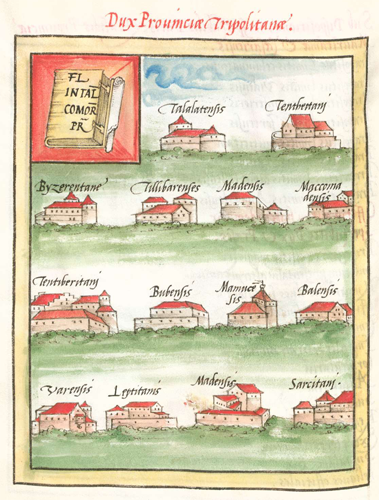
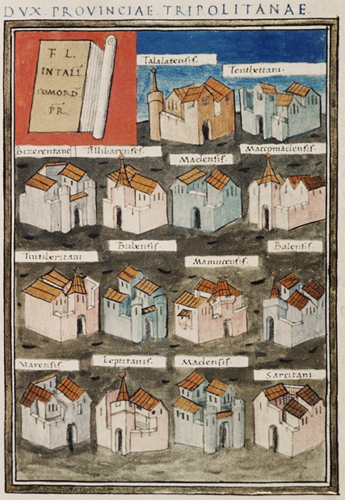
1. Maier, Ingo; "Appendix 4: Numeration of the new edition of the compilation 'notitia dignitatum' (Cnd)"; last accessed 26 October 2015. See also for here for numbering examples. Return
2. Isaac, Benjamin; "The meaning of the terms Limes and Limitanei"; The Journal of Roman Studies, 78 (1988), pp 125-147, available here (last accessed 30 Decber 2015). Return
3. Maier, I.G.; "The Barberinus and Munich codices of the 'Notitia Dignitatum omnium'"; Latomus 28.4 (1969) pp. 960-1035; at p 1022 in particular, available here (last accessed 12 December 2015). Return

Return to the Notitia index page.